-
Engine1.6L I4
-
Power138 HP / 123 LB-FT
-
Transmission6-Speed DCT
-
0-60 Time8.5 Seconds (est.)
-
Top Speed124 MPH
-
DrivetrainFront-Wheel Drive
-
Curb Weight2,813 LBS
-
Seating2+2
-
Cargo34.7 CU FT (max)
-
MPG29 City / 38 HWY
And This Time, It's Personal
In order to understand this review of the 2012 Hyundai Veloster, you first need to understand a bit about me. I'm a mid-twenty-something urbanite. My closet is full of obscure band t-shirts, striped hooded sweatshirts and Converse. My black-framed glasses match my messy dyed black hair. I go to a lot of concerts starring bands you've never heard of, I drink Pabst Blue Ribbon at dive bars that I 'check in' to on Facebook. Every photo I take has an Instagram filter. My Twitter feed is one big sarcastic abyss.
I'll sheepishly admit to being sort of a hipster, only without the Arcade Fire shirt and stupid mustache.
More to the point, I look like I stepped right out of a commercial for the Hyundai Veloster. All of the smiling, energetic folks pictured in the brochure at the dealership? They could pass as my friends.
It's no secret that Hyundai's new hatch is aimed squarely at my demographic – the always-connected scenester who works hard and plays harder. But does this new Veloster adequately meet the demands of my lifestyle? Forget about the fact that I'm an enthusiast first and a consumer second. If I had to go out and buy a new car tomorrow, would the Hyundai dealership be my destination?
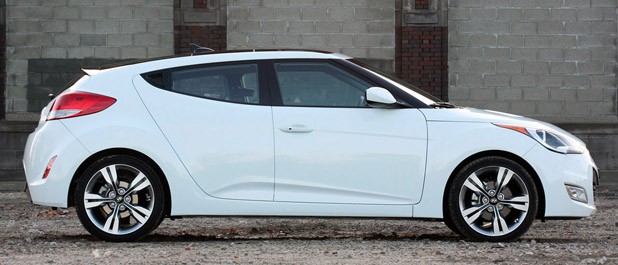
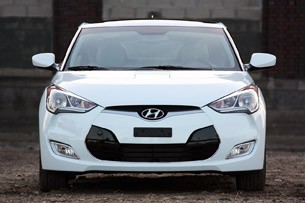
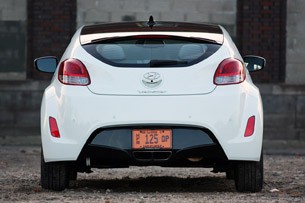
We're taught never to judge a book by its cover, but you can understand a lot about the Veloster just from its appearance: quirky, cool and not like anything else you'll get in the segment. Of course, all Veloster design dissections start with that trick third door – a neatly integrated, front-hinged rear door on the passenger side. Those with a trained eye will notice it straight away, but to my friends who had never heard of the Veloster, showing off that third door was always met with reactions of, "Woah, cool." Styling aside, the functional benefits are truly welcomed during grocery runs and when you need to throw an extra person or two in the back seats.
Behind that third door is a two-seat bench that'll easily house average-sized passengers, though taller folks will feel cramped. Ingress is a bit of a tough spot, as you'll need to duck while sliding in, but once inside, it's comfy. Even so, it's so much easier than doing the front seat shuffle in any other three-door hatchback and laughing as your friends clumsily stumble into the car's hind quarters. There isn't a ton of headroom up front, either, but the big issue here is side visibility. That high-riding, upward-sloping beltline causes a big ol' blind spot over your shoulder.
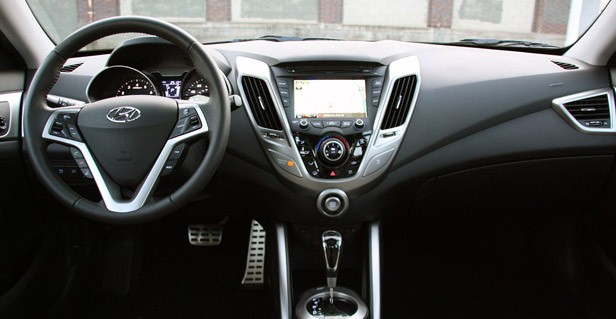
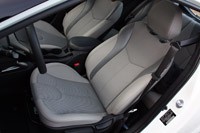
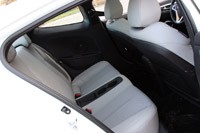
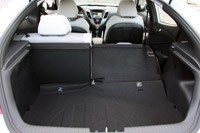
The Veloster comes nicely equipped and looks sharp even in its base trim, but if you have the dough, tick the $2,000 Style Package box that adds things like larger 18-inch wheels, a chrome grille surround, fog lights and a panoramic sunroof. The cool thing about that roof is that the glass stretches all the way back to meet the rear hatch and gives the Veloster a streamlined look, especially when contrasted by the Century White paint of our tester. That Style Package has some interior benefits, too, including leatherette trim on the seat bolsters and door inserts, a leather-wrapped steering wheel and shift knob, piano black interior accents and, of course, alloy pedals. If you're really feeling spendy, an extra $2,000 will get you the Technology Package that gets you a different style of 18-inch rollers (as seen on our test car), rear backup sensors, a navigation system and automatic headlamps.
All Velosters are treated to a wealth of standard equipment, including a colorful seven-inch LCD touchscreen mounted at the top of the center stack. All come with Hyundai's new BlueLink telematics system (think of it as OnStar for Hyundais), and opting for the Style or Tech packages will get you an upgraded stereo system with features like satellite radio and even Pandora. Don't even get me started on the other features of BlueLink, including the ability to check your efficiency versus other Veloster drivers and turn-by-turn directions. Instead, just know this: Your iPhone will be very, very jealous.
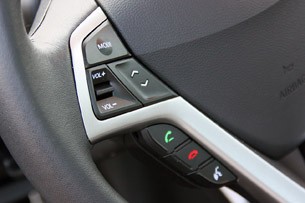
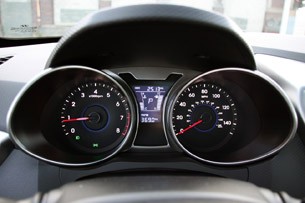
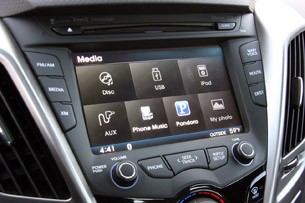
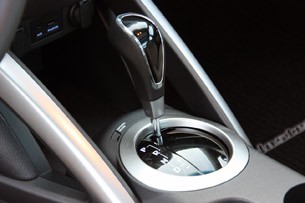
Before I talk about the powertrain, let's address the issue of the Veloster being underpowered. Read any other review of this car and you'll no doubt scan endless lines of text whining about how it could benefit from an additional 25 horsepower or some more low-end grunt. We won't argue that, but if performance is your thing, come back to the Hyundai dealer later this year when the 201-horsepower Turbo model goes on sale. You want a Veloster with proper enthusiast chops? The Turbo looks to be a willing partner.
The standard car uses Hyundai's 1.6-liter direct-injected inline-four – the same engine found in the Accent – good for 138 horsepower and 123 pound-feet of torque. That's adequate grunt for a car that only weighs 2,584 pounds (or 2,813 pounds all loaded up), and with either transmission – a six-speed manual or a six-speed dual-clutch unit like our test car – you can keep the engine revving high to make the most of the powerband. Of course, you won't net the EPA's 40 mile-per-gallon highway rating (38 mpg with the dual-clutch gearbox) if you keep the needle above 3,500 rpm, but if fuel economy isn't your big worry, the Veloster can be an entertaining little runabout. I only managed 34 mpg during my week-long test, but chalk that up to a heavy right foot and a want to drive this thing enthusiastically.
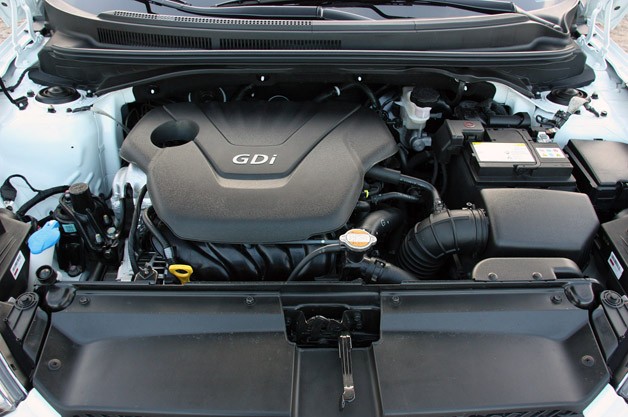
Right off the line, the Veloster is a bit sluggish – 0-60 estimates are in the high eight-second range – but the engine quickly revs high and you'll be scooting along just fine. Hyundai's EcoShift dual-clutch box is smooth and fires off crisp shifts, though we wish the response from the steering wheel-mounted paddles was a tick quicker. That, and the plastic paddles feel decidedly flimsy during finger flicking. Leave it in D and the transmission has a tendency to jump around between gears, but for the most part, it's smooth sailing.
Initially, I was worried that the Veloster's 18-inch Kumho Solus KH25 all-season tires and stiff-ish suspension would make for a harsh ride on the [insert synonym for "post-apocalyptic"] roads in and around Detroit, but the Hyundai is adequately smooth and stable, though a tad crashy on particularly bad stretches of pavement. The Veloster's electronic steering rack certainly isn't the best in the biz, but it's nicely weighted and makes the lightweight Veloster tossable in the city. It won't inspire lots of go-kart confidence like a Mini Cooper or even a Honda Fit, but it's enough to make the Veloster feel enthusiastic and engaging, especially when there isn't a ton of power on tap to play with.
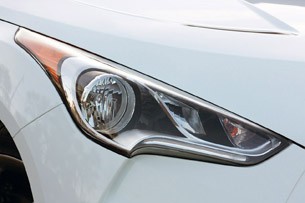
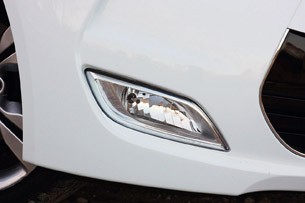
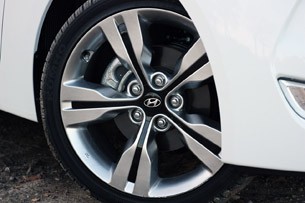
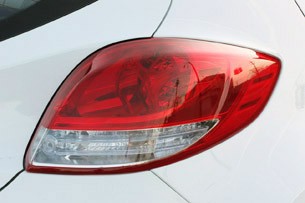
Normal front-wheel-drive characteristics like understeer and torque steer aren't apparent in the Veloster (you'd need substantially more torque to make that last one a possibility). Of course, if you push it really hard, the Hyundai will plow while entering a corner, but for 95 percent of driving, you'll never notice. But here's hoping that the front suspension has been upgraded on the Turbo model to handle the additional force from the more powerful engine.
Perhaps the biggest win for the Veloster is its price point: $18,075 (including $775 for delivery) will get you a solid package with plenty of standard kit. Add the dual-clutch 'box ($1,250), tech package ($2,000) and style package ($2,000), and you'll be at $23,325 all-in. Hyundai has long been known for offering tremendous value on its cars, and the Veloster is no different. For comparison, option a heavier (and slower), less-efficient (though a hybrid), less-functional Honda CR-Z to its top end and you're spending $1,000 more.
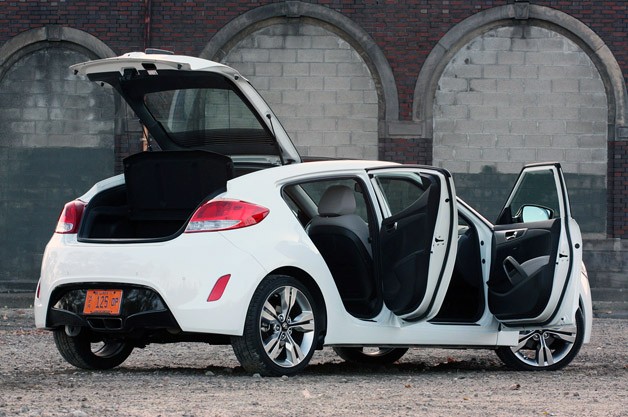
But for a mid-twenty-something, $23,325 is still a lot of coin. That'll get you a host of nicely equipped C-segment cars, many of which offer more interior space, more power and, in some cases, more efficiency (hat tip, Cruze Eco). What makes the Veloster stand out is its unique styling, incredible levels of standard equipment thanks to BlueLink, and the fact that it's more interesting than the majority of other econoboxes. Of course, Hyundai's excellent ten-year/100,000-mile warranty is a big win, too.
As I watched the Veloster leave my parking lot at the end of the week, I found myself ogling the design one last time. And with every three-door hatch I've driven since, I commonly think to myself, "This would be awesome with an additional door." The fact that all of my friends rallied around the Veloster speaks volumes, too. They all wanted to get in and check it out. If Hyundai markets this thing correctly, it could do for younger buyers what the original xB (a car I owned at one point – surprise, surprise) did for Scion and Toyota.
So do I want one? Only if I can claim I liked it before everyone else. Just make mine the Turbo.
In order to understand this review of the 2012 Hyundai Veloster, you first need to understand a bit about me. I'm a mid-twenty-something urbanite. My closet is full of obscure band t-shirts, striped hooded sweatshirts and Converse. My black-framed glasses match my messy dyed black hair. I go to a lot of concerts starring bands you've never heard of, I drink Pabst Blue Ribbon at dive bars that I 'check in' to on Facebook. Every photo I take has an Instagram filter. My Twitter feed is one big sarcastic abyss.
I'll sheepishly admit to being sort of a hipster, only without the Arcade Fire shirt and stupid mustache.
More to the point, I look like I stepped right out of a commercial for the Hyundai Veloster. All of the smiling, energetic folks pictured in the brochure at the dealership? They could pass as my friends.
It's no secret that Hyundai's new hatch is aimed squarely at my demographic – the always-connected scenester who works hard and plays harder. But does this new Veloster adequately meet the demands of my lifestyle? Forget about the fact that I'm an enthusiast first and a consumer second. If I had to go out and buy a new car tomorrow, would the Hyundai dealership be my destination?



We're taught never to judge a book by its cover, but you can understand a lot about the Veloster just from its appearance: quirky, cool and not like anything else you'll get in the segment. Of course, all Veloster design dissections start with that trick third door – a neatly integrated, front-hinged rear door on the passenger side. Those with a trained eye will notice it straight away, but to my friends who had never heard of the Veloster, showing off that third door was always met with reactions of, "Woah, cool." Styling aside, the functional benefits are truly welcomed during grocery runs and when you need to throw an extra person or two in the back seats.
Would we like a fourth door on the driver's side? Probably. But then the Veloster wouldn't be as unique – it'd be just another five-door hatch. That's not what Hyundai wanted, as evidenced by the fact that the automaker continues to maintain it has no plans to offer a proper five-door variant in the U.S.Would we like a fourth door on the driver's side? Probably. But then the Veloster wouldn't be as unique.
Behind that third door is a two-seat bench that'll easily house average-sized passengers, though taller folks will feel cramped. Ingress is a bit of a tough spot, as you'll need to duck while sliding in, but once inside, it's comfy. Even so, it's so much easier than doing the front seat shuffle in any other three-door hatchback and laughing as your friends clumsily stumble into the car's hind quarters. There isn't a ton of headroom up front, either, but the big issue here is side visibility. That high-riding, upward-sloping beltline causes a big ol' blind spot over your shoulder.




The Veloster comes nicely equipped and looks sharp even in its base trim, but if you have the dough, tick the $2,000 Style Package box that adds things like larger 18-inch wheels, a chrome grille surround, fog lights and a panoramic sunroof. The cool thing about that roof is that the glass stretches all the way back to meet the rear hatch and gives the Veloster a streamlined look, especially when contrasted by the Century White paint of our tester. That Style Package has some interior benefits, too, including leatherette trim on the seat bolsters and door inserts, a leather-wrapped steering wheel and shift knob, piano black interior accents and, of course, alloy pedals. If you're really feeling spendy, an extra $2,000 will get you the Technology Package that gets you a different style of 18-inch rollers (as seen on our test car), rear backup sensors, a navigation system and automatic headlamps.
Even without the upgrades, the interior of the Veloster is a sweet place to be. The seats are comfortable and nicely bolstered, and most of the buttons and knobs are simply laid out. We say "most of" only because the one issue is the engine start/stop button – it's located right at the bottom of the center stack, which is the last place you naturally think to look. Even more annoyingly, while driving a Veloster equipped with a manual transmission, I managed to turn off the engine at a stoplight while shifting into first gear with my hand loosely resting on the top of the shift knob.While driving a manual-equipped Veloster, I managed to turn off the engine at a stoplight while shifting into first gear.
All Velosters are treated to a wealth of standard equipment, including a colorful seven-inch LCD touchscreen mounted at the top of the center stack. All come with Hyundai's new BlueLink telematics system (think of it as OnStar for Hyundais), and opting for the Style or Tech packages will get you an upgraded stereo system with features like satellite radio and even Pandora. Don't even get me started on the other features of BlueLink, including the ability to check your efficiency versus other Veloster drivers and turn-by-turn directions. Instead, just know this: Your iPhone will be very, very jealous.




Before I talk about the powertrain, let's address the issue of the Veloster being underpowered. Read any other review of this car and you'll no doubt scan endless lines of text whining about how it could benefit from an additional 25 horsepower or some more low-end grunt. We won't argue that, but if performance is your thing, come back to the Hyundai dealer later this year when the 201-horsepower Turbo model goes on sale. You want a Veloster with proper enthusiast chops? The Turbo looks to be a willing partner.
The standard car uses Hyundai's 1.6-liter direct-injected inline-four – the same engine found in the Accent – good for 138 horsepower and 123 pound-feet of torque. That's adequate grunt for a car that only weighs 2,584 pounds (or 2,813 pounds all loaded up), and with either transmission – a six-speed manual or a six-speed dual-clutch unit like our test car – you can keep the engine revving high to make the most of the powerband. Of course, you won't net the EPA's 40 mile-per-gallon highway rating (38 mpg with the dual-clutch gearbox) if you keep the needle above 3,500 rpm, but if fuel economy isn't your big worry, the Veloster can be an entertaining little runabout. I only managed 34 mpg during my week-long test, but chalk that up to a heavy right foot and a want to drive this thing enthusiastically.

Right off the line, the Veloster is a bit sluggish – 0-60 estimates are in the high eight-second range – but the engine quickly revs high and you'll be scooting along just fine. Hyundai's EcoShift dual-clutch box is smooth and fires off crisp shifts, though we wish the response from the steering wheel-mounted paddles was a tick quicker. That, and the plastic paddles feel decidedly flimsy during finger flicking. Leave it in D and the transmission has a tendency to jump around between gears, but for the most part, it's smooth sailing.
Initially, I was worried that the Veloster's 18-inch Kumho Solus KH25 all-season tires and stiff-ish suspension would make for a harsh ride on the [insert synonym for "post-apocalyptic"] roads in and around Detroit, but the Hyundai is adequately smooth and stable, though a tad crashy on particularly bad stretches of pavement. The Veloster's electronic steering rack certainly isn't the best in the biz, but it's nicely weighted and makes the lightweight Veloster tossable in the city. It won't inspire lots of go-kart confidence like a Mini Cooper or even a Honda Fit, but it's enough to make the Veloster feel enthusiastic and engaging, especially when there isn't a ton of power on tap to play with.




Normal front-wheel-drive characteristics like understeer and torque steer aren't apparent in the Veloster (you'd need substantially more torque to make that last one a possibility). Of course, if you push it really hard, the Hyundai will plow while entering a corner, but for 95 percent of driving, you'll never notice. But here's hoping that the front suspension has been upgraded on the Turbo model to handle the additional force from the more powerful engine.
Perhaps the biggest win for the Veloster is its price point: $18,075 (including $775 for delivery) will get you a solid package with plenty of standard kit. Add the dual-clutch 'box ($1,250), tech package ($2,000) and style package ($2,000), and you'll be at $23,325 all-in. Hyundai has long been known for offering tremendous value on its cars, and the Veloster is no different. For comparison, option a heavier (and slower), less-efficient (though a hybrid), less-functional Honda CR-Z to its top end and you're spending $1,000 more.

But for a mid-twenty-something, $23,325 is still a lot of coin. That'll get you a host of nicely equipped C-segment cars, many of which offer more interior space, more power and, in some cases, more efficiency (hat tip, Cruze Eco). What makes the Veloster stand out is its unique styling, incredible levels of standard equipment thanks to BlueLink, and the fact that it's more interesting than the majority of other econoboxes. Of course, Hyundai's excellent ten-year/100,000-mile warranty is a big win, too.
As I watched the Veloster leave my parking lot at the end of the week, I found myself ogling the design one last time. And with every three-door hatch I've driven since, I commonly think to myself, "This would be awesome with an additional door." The fact that all of my friends rallied around the Veloster speaks volumes, too. They all wanted to get in and check it out. If Hyundai markets this thing correctly, it could do for younger buyers what the original xB (a car I owned at one point – surprise, surprise) did for Scion and Toyota.
So do I want one? Only if I can claim I liked it before everyone else. Just make mine the Turbo.










Sign in to post
Please sign in to leave a comment.
Continue